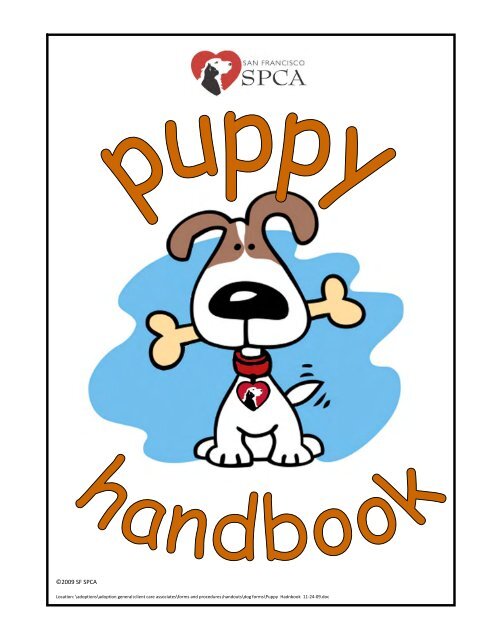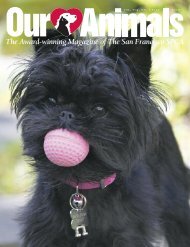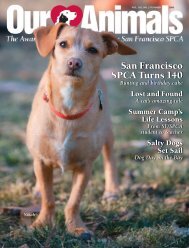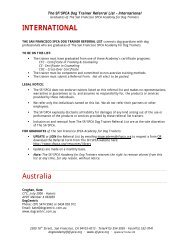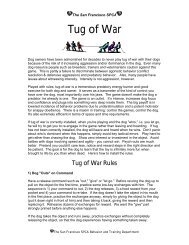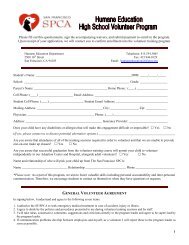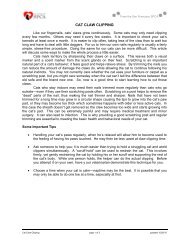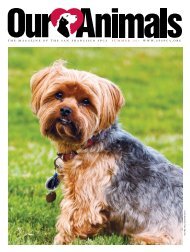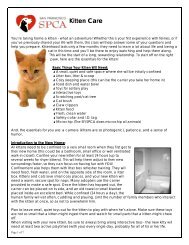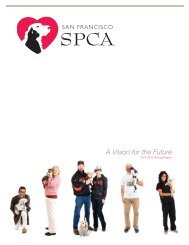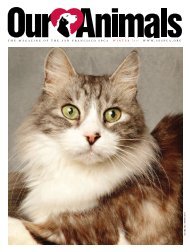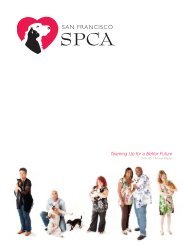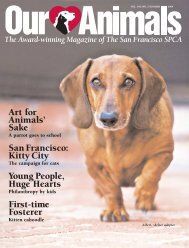Puppy Handbook for Adopters - San Francisco SPCA
Puppy Handbook for Adopters - San Francisco SPCA
Puppy Handbook for Adopters - San Francisco SPCA
Create successful ePaper yourself
Turn your PDF publications into a flip-book with our unique Google optimized e-Paper software.
©2009 SF <strong>SPCA</strong><br />
Location: \adoptions\adoption general\client care associates\<strong>for</strong>ms and procedures\handouts\dog <strong>for</strong>ms\<strong>Puppy</strong> Hadnbook 11‐24‐09.doc
from the <strong>San</strong> <strong>Francisco</strong> <strong>SPCA</strong> Dog Training Department<br />
<strong>Puppy</strong> <strong>Handbook</strong> (11/24/2009) 2
CONTENTS<br />
from the <strong>San</strong> <strong>Francisco</strong> <strong>SPCA</strong> Dog Training Department<br />
Your New <strong>Puppy</strong>......................................................................................................................................................... 4<br />
Confinement and Crate Training ........................................................................................................................... 5<br />
<strong>Puppy</strong> Housetraining Checklist .............................................................................................................................. 8<br />
Managing Your Dog’s Behavior............................................................................................................................. 10<br />
Why <strong>Puppy</strong> Training? .............................................................................................................................................. 11<br />
<strong>Puppy</strong> Socialization................................................................................................................................................. 12<br />
<strong>Puppy</strong> Socialization Chart ..................................................................................................................................... 13<br />
Vaccination And Socialization.............................................................................................................................. 14<br />
Time Out!.................................................................................................................................................................. 15<br />
<strong>Puppy</strong> Mouthing ....................................................................................................................................................... 17<br />
Play Biting In Puppies............................................................................................................................................. 18<br />
<strong>Puppy</strong> Chew-Training.............................................................................................................................................. 19<br />
<strong>Puppy</strong> Handling / Grabbing and Restraint .........................................................................................................20<br />
Food Bowl Exercises .............................................................................................................................................. 21<br />
Lure/Reward Training............................................................................................................................................22<br />
Home Alone Training..............................................................................................................................................23<br />
Kong Stuffing Pointers..........................................................................................................................................24<br />
Recommended Reading ..........................................................................................................................................26<br />
Great Resources .....................................................................................................................................................28<br />
Popular Dog Supplies/Shopping List............................................................................................................. 28<br />
Local Stores........................................................................................................................................................29<br />
Online Shopping..................................................................................................................................................29<br />
Additional Resources ........................................................................................................................................29<br />
Dog Daycare........................................................................................................................................................30<br />
Dog Walkers and Petsitters..............................................................................................................................31<br />
<strong>Puppy</strong> <strong>Handbook</strong> (11/24/2009) 3
YOUR NEW PUPPY<br />
from the <strong>San</strong> <strong>Francisco</strong> <strong>SPCA</strong> Dog Training Department<br />
Congratulations on your puppy adoption! Adopting a puppy is a huge but rewarding<br />
responsibility. It requires a great deal of time and ef<strong>for</strong>t by everyone in the family<br />
to socialize, exercise, train and care <strong>for</strong> the pup so that he or she can grow up to be<br />
a wonderful, well-mannered adult. We at the <strong>San</strong> <strong>Francisco</strong> <strong>SPCA</strong> want to ensure that<br />
people who adopt a puppy from us are prepared to do that.<br />
This handbook is designed to help you and your newly adopted pup get off to the right<br />
start until you are able to start the puppy class you have enrolled in. The first few pages<br />
are devoted to what you need to know right away:<br />
� where to put your puppy as soon as you get home<br />
� how to manage house training.<br />
The rest of this handbook covers important topics such as socialization, common puppy<br />
behavior issues, training, and helpful resources.<br />
From the moment you choose your puppy, the urgency of socializing and training has<br />
begun. An adult dog's temperament and behavior habits (both good and bad) are shaped<br />
during puppyhood – very early puppyhood. Remember it takes a human baby 13 years to get<br />
to the same point of maturity that it takes a puppy only a year or less to get to! ∗<br />
Please take some time to review the in<strong>for</strong>mation in this handbook. It is intended to answer<br />
most questions that new puppy adopters have. If you do have a question about the puppy<br />
you just adopted, or there is something in this material you do not understand, please call<br />
us at 415.554.3075. Leave a message briefly outlining your question or problem and we will<br />
get back to you as quickly as possible.<br />
Again, congratulations on your new puppy. Enjoy the adventure!<br />
∗ from Be<strong>for</strong>e You Get Your <strong>Puppy</strong>, by Ian Dunbar<br />
<strong>Puppy</strong> <strong>Handbook</strong> (11/24/2009) 4
from the <strong>San</strong> <strong>Francisco</strong> <strong>SPCA</strong> Dog Training Department<br />
CONFINEMENT AND CRATE TRAINING<br />
Owners are often unsure whether they need to crate-train their puppies or newly adopted dogs or<br />
whether to simply confine them in a dog-proofed area during the early weeks or months following<br />
adoption. Here is some in<strong>for</strong>mation to help you decide if crate training is <strong>for</strong> you.<br />
Crate training helps with the following:<br />
� Housetraining. Prompts the dog to hold bladder and<br />
bowels when unsupervised to expedite housetraining.<br />
� Chew-training. Prevents the dog from chewing furniture,<br />
walls and anything else except the chew toys he is crated<br />
with so good habits automatically <strong>for</strong>m.<br />
� Settling down. Patterns dog to be inactive when alone.<br />
� Owner as good guy. By decimating housetraining and<br />
chew-training mistakes, dog partially “self-trains,”<br />
reducing amount of reprimanding and bad-guy stuff <strong>for</strong><br />
owner.<br />
� Preparation <strong>for</strong> possible close confinement. Dogs that are used to close confinement are<br />
less likely to be stressed when caged during a hospital stay or travel.<br />
Chewing and activity management could be accomplished with a well dog-proofed room or an ex-pen<br />
and these are alternatives if the dog is solid in his elimination habits. If the dog is shaky on<br />
housetraining, however, you’re better off crate-training him as the close confinement will inhibit<br />
urination and defecation. To get the crating effect, the crate should be only large enough <strong>for</strong> the<br />
dog to stand up and turn around in. An ex-pen, dog-proofed room or too-large crate allows the dog<br />
to use one end as bathroom area and the other end as bed.<br />
How To Get Him Used to His Crate<br />
You can’t just throw the dog in the crate and expect him to adjust. That would be traumatic. Early<br />
association is important and, often, indelible. Make the crate comfy with a nice crate pad or<br />
blanket 1 , situate it in a high traffic area like the kitchen and, whenever the dog isn't looking, drop a<br />
couple of treats at the back. Don’t point these out to him; rather let him discover them on his own.<br />
Feed him meals in there, always with the door open. Using heavy string, tie an attractive stuffed<br />
chew-toy to the rear inside so that the dog must lie in the crate in order to chew on it.<br />
After a few days of this, start teaching the dog to enter and exit on command. Say "into bed" or<br />
"into the crate," throw in a treat, praise as the dog goes in and eats the treat and then order him<br />
1 Later on, if you discover your dog is soiling his crate, the first thing to try is removing the pad or blanket <strong>for</strong> a week – the<br />
porous material may be triggering elimination. Be sure, also, that you are not stretching the dog too long between bathroom<br />
trips and <strong>for</strong>cing him to eliminate in his crate. Keep both the dog and the crate scrupulously clean. It would be prudent to<br />
have him checked <strong>for</strong> a bladder infection if he is urinating really often. Finally, a minority of dogs are just not inhibited<br />
from eliminating by crates or have lost their cleanliness instinct by being confined continuously. Call us <strong>for</strong> pointers if you<br />
can’t get your dog to stop soiling his crate.<br />
<strong>Puppy</strong> <strong>Handbook</strong> (11/24/2009) 5
from the <strong>San</strong> <strong>Francisco</strong> <strong>SPCA</strong> Dog Training Department<br />
out with the command of your choice. Encourage him to come out and, when he does, praise him (no<br />
food treat <strong>for</strong> exiting). Repeat this a few times and then change the order of events slightly:<br />
instead of throwing the treat into the crate after you say "into bed," wait <strong>for</strong> him to go in on his<br />
own be<strong>for</strong>e dropping in the treat. If the dog doesn't enter on command, simply wait. Do not<br />
command him a second time and do not crack and throw the treat in. You can encourage him in with<br />
hand gestures but even this is riskier than simply waiting. If he doesn't go in, end the training<br />
session without comment. Try another session in a little while, still withholding the reward until the<br />
dog goes in on his own. When he does (and they all do eventually so hang in there), give him a double<br />
or triple reward, do a few more rewarded reps and then end the session. Always leave the dog<br />
wanting more.<br />
When the dog is going in and out on command, you are ready to try the<br />
first lock-in. Play the in/out of the crate game, only now close the door<br />
after he has gone in and feed him treats through the grate <strong>for</strong> a minute<br />
or two be<strong>for</strong>e opening the door. Do this several times. Then practice<br />
walking around the crate and around the room while he is locked inside,<br />
pitching treats at him occasionally and then, after a couple of minutes,<br />
opening the door and letting him out. Make the whole thing a positive<br />
experience <strong>for</strong> him. The next step is to add some real duration.<br />
Rent yourself a favorite video and stuff a couple of chew-toys with something extra-special. Set<br />
the crate up right next to your comfy movie chair and, just be<strong>for</strong>e you sit down to enjoy the movie,<br />
order the dog into the crate. When he goes in, give him the chew toys, close the crate door and<br />
start the movie. Leave a few times to get popcorn, a drink, but always come back within a minute or<br />
so. The first experience being locked in the crate <strong>for</strong> this length of time must be an<br />
overwhelmingly easy and good one. Any noise, agitation or tantrum from the dog should be ignored.<br />
At the end of the movie, if the dog is quiet and settled in the crate, simply open the door and order<br />
him out. Under no circumstances will you open the door to the crate if the dog is misbehaving;<br />
otherwise you are conditioning that behavior. If you do not like it, do not reward it. When you do<br />
open the door, don't gush and hug the dog. Make the exit an anticlimax. Behave very neutrally. All<br />
the good stuff should happen while he's IN the crate, behaving nicely.<br />
Once he's out, order him right back in <strong>for</strong> a food treat or two without closing the door be<strong>for</strong>e you<br />
finish your training/movie session. If he refuses to go in, do whatever it takes to get him in,<br />
reward him and get your in/out exercise polished up again.<br />
Now spend a few days locking the dog in the crate when you're at home, going about your usual<br />
business. Ignore or reprimand any noise and provide interesting crate puzzles (i.e., chew toys) each<br />
time. When the dog is going in without fuss and no longer distress vocalizing, you may start leaving<br />
the house. Leave <strong>for</strong> one to ten seconds over and over <strong>for</strong> the first “leaving home” session. Then,<br />
over the next few sessions, gradually extend the time you are gone, from a minute to five minutes<br />
to ten, fifteen, thirty, an hour, two, three and four hours. Throw in some short ones (5 to 60<br />
seconds) in between to mix it up. Depart and arrive without any fanfare. Tire the dog out with<br />
vigorous exercise and training be<strong>for</strong>e the longest absences. It is important to gradually condition<br />
the dog to being in the crate this way be<strong>for</strong>e using it in your day to day life.<br />
<strong>Puppy</strong> <strong>Handbook</strong> (11/24/2009) 6
from the <strong>San</strong> <strong>Francisco</strong> <strong>SPCA</strong> Dog Training Department<br />
<strong>Puppy</strong> <strong>Handbook</strong> (11/24/2009) 7
� Schedule<br />
from the <strong>San</strong> <strong>Francisco</strong> <strong>SPCA</strong> Dog Training Department<br />
PUPPY HOUSETRAINING CHECKLIST<br />
We strongly recommend you crate-train your puppy. It is vital <strong>for</strong> both house- training and<br />
chew-training. Crate-training exploits a puppy’s instinct to keep his bed clean. It gradually<br />
tones up his flabby little puppy muscles. This plus a smaller bladder and frequent meals all<br />
add up to a need <strong>for</strong> much more frequent elimination.<br />
� First thing in the morning (very first thing)<br />
� After eating<br />
� After waking from a nap<br />
� Young puppies (8 – 10 weeks) usually need to go out every hour at least<br />
� Last thing be<strong>for</strong>e bed<br />
If puppy doesn’t eliminate on any particular outing, crate him with a chew toy to avoid an<br />
accident (puppy is full or near full!). Try again in 30 minutes.<br />
� Crate Duration<br />
� Location<br />
� Do not leave puppy in crate too long as this will <strong>for</strong>ce him to soil it and may result in<br />
ruining his tendency to want to keep it clean. Here are some suggested guidelines:<br />
Weeks Old Hours at a Time in Crate<br />
8-10 1 hour max<br />
11-12 2 hours max<br />
13-16 3 hours max<br />
17-20+ 4 hours max<br />
HOUSETRAINING<br />
CHECKLIST<br />
� Use a long-term confinement area <strong>for</strong> times that are longer than the puppy can hold in<br />
the crate.<br />
Kitchen is an ideal confinement area – not too large, high traffic, easy-to-clean floor.<br />
Confine with pet-proof gates – newspaper at one end; bed, food, water, toys at other.<br />
Go to the same spot to make it easier, or at least the same kind of surface<br />
Accompany your dog to eliminate – go with him rather than sending him so that:<br />
� You know whether he’s gone or not<br />
� You can reward at the right instant – praise and small food treat as he finishes.<br />
<strong>Puppy</strong> <strong>Handbook</strong> (11/24/2009) 8
from the <strong>San</strong> <strong>Francisco</strong> <strong>SPCA</strong> Dog Training Department<br />
Praise and reward all outdoor elimination <strong>for</strong> first few weeks – later can slack off (okay<br />
to continue praising).<br />
Praise and reward every time he gets it right.<br />
� If you catch your dog making a mistake:<br />
� Interrupt him (“Ah! Ah! Let’s go outside!”) at the start of any mistakes indoors, then<br />
hustle him outside or to the right spot to finish. If he finishes there, praise and<br />
reward this. Note: interrupt, not punish.<br />
� Punishing a dog <strong>for</strong> house training mistakes can cause the dog to fear eliminating in<br />
front of you, and can teach him to hide his mistakes from you by going behind<br />
couches/chairs/beds or in closets and other hidden areas.<br />
� If your dog makes a mistake while you are not there, never, ever punish. You need to<br />
catch the dog in the act in order to respond to his behavior.<br />
� Clean all accidents thoroughly with an enzymatic cleanser (e.g. Nature’s Miracle, Anti-<br />
Icky-Poo, Petastic).<br />
� After two or three weeks with no accidents, add one extra room of the house and supervise<br />
closely. If the puppy is successful, add another room every two or three weeks.<br />
� Starting at age three months, gradually extend the duration between outings – add one half<br />
hour every week or two. If puppy starts having accidents, back off and do more frequent<br />
outings <strong>for</strong> a couple of weeks, then try again.<br />
� It is reasonable to expect an adult dog to hold on 4 – 5 hours max. Of course, many dogs can<br />
hold on longer but is it humane to make them?<br />
� If you are having difficulties, call our help line (415.554.3075) or, to find a dog trainer, visit<br />
www.sfspca.org <strong>for</strong> our Academy Alumni referral list.<br />
<strong>Puppy</strong> <strong>Handbook</strong> (11/24/2009) 9
from the <strong>San</strong> <strong>Francisco</strong> <strong>SPCA</strong> Dog Training Department<br />
MANAGING YOUR DOG’ ’S BEHAVIOR<br />
Puppies come with a set of pre-installed behaviors: urinating and defecating when they feel the<br />
urge, chewing anything they can put in their mouths, whining, crying and barking if they find<br />
themselves alone, eating any food they encounter (not to mention many NON-food items!), greeting<br />
by excitedly jumping up, and play-biting all living things. These are all normal behaviors <strong>for</strong> any<br />
puppy or untrained adult dog. Notice that there is little on this list that humans are likely to<br />
approve of.<br />
In order to have a dog that chews only his own toys, eliminates outside, can relax alone quietly,<br />
greets without jumping up and plays without being mouthy, the onus is on us humans to mold the<br />
dog’s behavior. Puppies need management and the safest policy with newly adopted dogs is to treat<br />
them as though they were puppies too!<br />
Here are some important rules <strong>for</strong> managing your new puppy or dog:<br />
� Confine any puppy or untrained dog to one room, like the kitchen, to make dog-proofing the<br />
room and supervision easier.<br />
� Supervise like crazy: feedback about both housetraining and chewing lapses has to be<br />
immediate. Never punish a dog late: it is ineffective and abusive. If you don’t have time to<br />
supervise (or train or burn energy etc.) don’t get a dog.<br />
� Help him get it right most of the time: provide stuffed chew toys and praise him when he<br />
uses them, take him out often (every hour <strong>for</strong> a young puppy!) and praise & reward him<br />
immediately when he per<strong>for</strong>ms outside, enroll in a reward-based training course to teach you<br />
how to communicate with him.<br />
� Don’t reward whining or barking when the dog is left alone by returning to the dog – this<br />
teaches him that whining works and that you can be manipulated. Get him used to being<br />
alone by coming and going ZILLIONS of times <strong>for</strong> very short periods the first few days you<br />
have him, all done very matter of factly.<br />
� Burn your dog’s energy, both physical and mental! Tired dogs are well-behaved dogs. Teach<br />
him basic commands and tricks with treats, play fetch, tug and hide & seek with his toys,<br />
take up a sport like agility or flyball, get him out daily <strong>for</strong> walks & runs, trips to new places<br />
and give him regular opportunities to play with other dogs. If you work long hours, consider<br />
a walker, or day-care.<br />
<strong>Puppy</strong> <strong>Handbook</strong> (11/24/2009) 10
WHY PUPPY TRAINING?<br />
from the <strong>San</strong> <strong>Francisco</strong> <strong>SPCA</strong> Dog Training Department<br />
Until recently, most dog training methods relied heavily on aversives as principle<br />
means of motivation. <strong>Puppy</strong> owners were admonished to not begin training until at<br />
least six months of age, not because of an inability to learn but because puppies<br />
were unable to withstand the coercive techniques. Valuable time was thus lost.<br />
Starting in the early 1980’s, methods that employed positive rein<strong>for</strong>cement (e.g. lurereward,<br />
clicker training) began to revolutionize dog training. Today, although <strong>for</strong>ce<br />
training still exists, the dominant <strong>for</strong>ce in dog training is increasingly conditioning with<br />
positive rein<strong>for</strong>cement. The best news of all is that, far from being contraindicated <strong>for</strong><br />
small puppies, training with positive rein<strong>for</strong>cement is ideally suited to puppies. There is<br />
virtually no limit to what puppies can learn, if the method is right. Some of the advantages<br />
of puppy training are:<br />
<strong>Puppy</strong> training begins instilling obedience and good manners be<strong>for</strong>e bad habits and<br />
unruliness become entrenched.<br />
<strong>Puppy</strong> training makes use of the critical socialization period to habituate dogs to all<br />
kinds of people, other dogs, novel environments and being handled.<br />
Starting training early creates a “learning to learn” effect, stimulates the puppy’s<br />
brain and paves the way <strong>for</strong> later training.<br />
<strong>Puppy</strong> training allows <strong>for</strong> timely troubleshooting of common puppy problems such as<br />
play-biting, alone-training, house-training and chew-training.<br />
<strong>Puppy</strong> training is easy, fun and can be done by all family members, including children.<br />
You wouldn’t wait until your child was a teenager to start his education, would you?<br />
<strong>Puppy</strong> class at the SF/<strong>SPCA</strong> is <strong>for</strong> vaccinated puppies up to 18 weeks of age on the first<br />
week of class. All family members are encouraged to attend. The six week introductory<br />
course includes homework, written materials and puppy party graduation. For more<br />
in<strong>for</strong>mation or to enroll, please visit us on the web at<br />
www.sfspca.org/dog_training/dt_puppy.shtml, email us at dogtraining@sfspca.org or call us<br />
at 415.522.3509.<br />
<strong>Puppy</strong> <strong>Handbook</strong> (11/24/2009) 11
PUPPY SOCIALIZATION<br />
People, Sights and Sounds<br />
Between the ages of 3 and 12 weeks, puppies are<br />
<strong>for</strong>ming bonds toward people, dogs and other animals<br />
that will last them a lifetime. Puppies that are not<br />
exposed to and do not have good experiences with<br />
people, dogs and other animals during this period can<br />
end up with fear and aggression problems later on.<br />
All out ef<strong>for</strong>ts must be made to get the puppy around<br />
all kinds of people and to make sure your pup has good<br />
experiences (play, pets and/or treats) with them all.<br />
This includes children, people of different races, folks<br />
who are big or loud, ones in uni<strong>for</strong>m, etc. (If your pup is<br />
not fully immunized you may choose to carry him<br />
around.) By the way, supermarkets are a great place to<br />
see lots of different folks!<br />
As soon as possible, enroll your pup in a reward-based<br />
puppy class. This will be the ideal place <strong>for</strong> your pup to<br />
make some puppy friends his own age.<br />
If possible, it's a good idea to introduce your pup to a<br />
social cat as soon as possible to maximize his chances of<br />
growing up to like cats.<br />
Puppies are cataloging other things in their environment<br />
besides people and animals. Make sure he sees and<br />
hears household things like the vacuum cleaner, TV, the<br />
clatter of pots and pans, etc. He should also<br />
experience car rides, traffic noises and all kinds of<br />
environments and weather. If you get the chance,<br />
bundle him up, take him out and share a few moments in<br />
the rain. And please, avoid negative experiences.<br />
from the <strong>San</strong> <strong>Francisco</strong> <strong>SPCA</strong> Dog Training Department<br />
<strong>Puppy</strong> <strong>Handbook</strong> (11/24/2009) 12
PUPPY SOCIALIZATION CHART<br />
from the <strong>San</strong> <strong>Francisco</strong> <strong>SPCA</strong> Dog Training Department<br />
Check off each completed encounter in the appropriate box. Mark as many encounters as possible. Notice if there is any fear associated with<br />
any of these situations/persons. Give treats to your puppy intermittently during all socialization and let others give treats as well.<br />
People<br />
Young adults<br />
Middle aged adults<br />
Elderly<br />
Disabled; odd gaits<br />
Loud<br />
Looming<br />
Uni<strong>for</strong>med<br />
with hats<br />
with beards<br />
with glasses<br />
with helmets<br />
with gloves<br />
with umbrellas<br />
Babies<br />
Toddlers<br />
Juniors<br />
Teens<br />
Animals<br />
Puppies<br />
Adult dogs<br />
Cats/kittens<br />
Small pets<br />
Livestock<br />
Horses<br />
Places<br />
Beach/ocean<br />
Shopping malls<br />
Friends homes<br />
Parks<br />
Near a schoolyard<br />
Riding in car<br />
City streets<br />
Slippery floors<br />
Party<br />
Vet's office<br />
Groomers<br />
Vehicles<br />
Bicycles<br />
Motorcycles<br />
Buses<br />
Trucks<br />
Shopping Carts<br />
Skateboards/rollerblades<br />
8-9<br />
wks<br />
<strong>Puppy</strong> <strong>Handbook</strong> (11/24/2009) 13<br />
9-10<br />
wks<br />
10-11<br />
wks<br />
11-12<br />
wks<br />
12-13<br />
wks<br />
3-6<br />
mths<br />
6-10<br />
mths
from the <strong>San</strong> <strong>Francisco</strong> <strong>SPCA</strong> Dog Training Department<br />
VACCINATION AND SOCIALIZATION<br />
Robert K. Anderson DVM<br />
Diplomate AC VB and AC VPM<br />
Professor and Director Emeritus, Animal Behavior Clinic and<br />
Center to Study Human/Animal Relationships and Environments<br />
University of Minnesota<br />
1666 Coffman Street, Suite 128, Falcon Heights, MN 55108<br />
Phone 612-644-7400 FAX 612-644-4262<br />
TO: My Colleagues in Veterinary Medicine:<br />
<strong>Puppy</strong> Vaccination and Socialization Should Go Together<br />
Common questions I receive from puppy owners, dog trainers and veterinarians concern: 1) what is the most favorable age or<br />
period of time when puppies learn best? 2) what are the health implications of my advice that veterinarians and trainers should<br />
offer socialization programs <strong>for</strong> puppies starting at 8 to 9 weeks of age.<br />
Puppies begin learning at birth and their brains appear to be particularly responsive to learning and retaining experiences that<br />
are encountered during the first 13 to 16 weeks after birth. This means that breeders, new puppy owners, veterinarians, trainers<br />
and behaviorists have a responsibility to assist in providing these learning/socialization experiences with other puppies/dogs,<br />
with children/adults and with various environmental situations during this optimal period- from birth to 16 weeks.<br />
Many veterinarians are making this early socialization and learning program part of a total wellness plan <strong>for</strong> breeders and new<br />
owners of puppies during the first 16 weeks of a puppy's life -- the first 7-8 weeks with the breeder and the next 8 weeks with<br />
the new owners. This socialization program should enroll puppies from 8 to 12 weeks of age as a key part of any preventive<br />
medicine program to improve the bond between pets and their people and keep dogs as valued members of the family <strong>for</strong> 12 to<br />
18 years.<br />
To take full advantage of this early special learning period, many veterinarians recommend that new owners take their puppies<br />
to puppy socialization classes, beginning at 8 to 9 weeks of age. At this age they should have (and can be required to have)<br />
received a minimum of their first series of vaccines <strong>for</strong> protection against infectious diseases. This provides the basis <strong>for</strong><br />
increasing immunity by further repeated exposure to these antigens either through natural exposure in small doses or artificial<br />
exposure with vaccines during the next 8 to 12 weeks. In addition the owner and people offering puppy socialization should<br />
take precautions to have the environment and the participating puppies as free of natural exposure as possible by good hygiene<br />
and caring by careful instructors and owners.<br />
Experience and epidemiologic data support the relative safety and lack of transmission of disease in these puppy socialization<br />
classes over the past 10 years in many parts of the United States. In fact; the risk of a dog dying because of infection with<br />
distemper or parvo disease is far less than the much higher risk of a dog dying (euthanasia) because of a behavior problem.<br />
Many veterinarians are now offering new puppy owners puppy socialization classes in their hospitals or nearby training<br />
facilities in conjunction with trainers and behaviorists because they want socialization and training to be very important parts<br />
of a wellness plan <strong>for</strong> every puppy. We need to recognize that this special sensitive period <strong>for</strong> learning is the best opportunity<br />
we have to influence behavior <strong>for</strong> dogs and the most important and longest lasting part of a total wellness plan.<br />
Are there risks? Yes. But 10 years of good experience and data, with few exceptions, offers veterinarians the opportunity to<br />
generally recommend early socialization and training classes, beginning when puppies are 8 to 9 weeks of age. However, we<br />
always follow a veterinarian's professional judgment, in individual cases or situations, where special circumstances warrant<br />
further immunization <strong>for</strong> a special puppy be<strong>for</strong>e starting such classes. During any period of delay <strong>for</strong> puppy classes, owners<br />
should begin a program of socialization with children and adults, outside their family, to take advantage of this special period<br />
in a puppy's life.<br />
If there are further questions, veterinarians may call me at 651-644-7400 <strong>for</strong> discussion and clarification.<br />
Robert K. Anderson DVM, Diplomate, American College of Veterinary Preventive Medicine and Diplomate of American<br />
College of Veterinary Behaviorists<br />
<strong>Puppy</strong> <strong>Handbook</strong> (11/24/2009) 14
from the <strong>San</strong> <strong>Francisco</strong> <strong>SPCA</strong> Dog Training Department<br />
How do players of organized sports learn to curb misbehavior in the game? Ejection! This<br />
principle of removing someone from a pleasurable activity to change future behavior works<br />
well in dog training too. The timeout functions as a penalty <strong>for</strong> the dog. Traditionally,<br />
behaviors you are looking to suppress respond well to timeouts. Things such as jumping up,<br />
begging at tables/plates, nipping at ankles and hands, and "gimme" barking can all be<br />
curbed using timeouts. The following steps should be followed to train with timeouts.<br />
Setups<br />
by Fawn Pierre<br />
©2001<br />
The best way to deliver a timeout is to do a "setup" of the situation in the beginning. For<br />
example, don't try to train a dog to leave you alone when you are eating by trying to<br />
practice it when you are hungry and trying to eat. Instead, produce a situation that looks<br />
just like dinner, but in reality is a training scenario where you are not hungry and the goal<br />
isn't "to eat", but to train the dog.<br />
Define Your Criteria<br />
This means decide be<strong>for</strong>e you begin which behaviors will earn your dog a timeout. For<br />
example, if you wish to curb begging at the table, decide WHAT exactly constitutes<br />
begging. BE SPECIFIC - some examples would be; paws on human, nose on human, paws or<br />
nose on table or within 1 foot of table and barking. Once you have done that, you have<br />
given yourself a mental picture of what you are going to be watching <strong>for</strong>, it will be easier<br />
to mark it and give your timeout.<br />
Location, Location, Location!<br />
How and where you deliver your timeout is important. Leash your dog be<strong>for</strong>e beginning: if<br />
your dog is leashed, you won't have to play "greased pig" trying to grab him to move him to<br />
the timeout area. Secondly, if he is leashed, you can give a timeout on any doorknob in the<br />
house. When you choose the area to give a timeout in, it should be sufficiently away from<br />
the action, to get the point across, but close enough to facilitate easy execution of the<br />
exercise. Don't plan on sending the dog to the yard, or kennel if it takes more than 10<br />
seconds to get there.<br />
<strong>Puppy</strong> <strong>Handbook</strong> (11/24/2009) 15<br />
TIME OUT!
You’re OUT!<br />
from the <strong>San</strong> <strong>Francisco</strong> <strong>SPCA</strong> Dog Training Department<br />
You'll need to pick a word or phrase to use to mark the behavior that earns your dog the<br />
penalty. Don't use simply "no". Your marker word need not be emotional, the word isn't<br />
the punishment, the social isolation that follows it is. The word simply says to the dog,<br />
"your (jumping/nipping/etc.) earned you this timeout”. Many people use "too bad", or<br />
"sorry". You might try "Mucky!" or "buh bye” as it may help you relax and not be so<br />
serious. The word can be delivered deadpan or with some emotion, but shouldn't be scary<br />
to the dog. And you don't need to shout.<br />
Repetition<br />
For timeouts to be effective they need to be of a short duration. One minute is quite<br />
effective. They must also be repeated numerous times. Mark the dog's misbehavior, give<br />
the timeout; after one minute release the dog, and return to the area to allow your dog to<br />
try again. The dog normally will do the exact behavior again. You then deliver another<br />
timeout. It usually takes between 6 - 12 repetitions be<strong>for</strong>e you see the dog self censor.<br />
<strong>Puppy</strong> <strong>Handbook</strong> (11/24/2009) 16
PUPPY MOUTHING<br />
from the <strong>San</strong> <strong>Francisco</strong> <strong>SPCA</strong> Dog Training Department<br />
Puppies are programmed to bite; in a litter of puppies they bite each other continuously.<br />
When one puppy bites the other too hard, the bitten puppy will yelp and stop playing. This<br />
is how dogs learn to inhibit the <strong>for</strong>ce of their bite. Probably one of the most important<br />
things you must teach a pup is to have a soft mouth… if you <strong>for</strong>bid your puppy's mouthing,<br />
he will grow up to have a rude/hard mouth. The best technique <strong>for</strong> hard bites is to remove<br />
the thing your puppy wants most ... YOU!<br />
First, set up a puppy-proof room which will be your "time-out" area - a bathroom, kitchen<br />
or utility room usually works best.<br />
As soon as you feel a hard bite, dramatically yell “OUCH” and “ENOUGH”. If the puppy<br />
pulls back, begins to lick or stops biting, immediately praise and continue playing. If she<br />
does not immediately stop biting hard, quickly move her to her time-out area <strong>for</strong> 10 to 20<br />
seconds. (You'll find it very helpful to leave a light nylon leash attached to your pup's<br />
collar <strong>for</strong> this purpose.) When taking her away, make it a big deal -- "OKAY THAT'S IT!<br />
I'M OUT-A-HERE! YOU'VE CROSSED THE LINE" -- repeating your make believe horror<br />
until you have arrived at the time-out location. Hopefully, this should only take a few<br />
seconds.<br />
After the 10 to 20 second penalty phase is over, resume interacting with your pup where<br />
you left off, without a grudge. Go back to her talking in your happiest, giggliest voice.<br />
The important thing is that the pup learns that there is an immediate consequence <strong>for</strong><br />
hard bites: being without a playmate and ALONE! Repeat several times or until you notice<br />
a marked difference in the pressure of the bites. Always keep in mind it's the hard bites<br />
you want to discourage, not her playfulness or his love of you and life!<br />
Practice mouthing exercises while you are being a couch potato. Feed her kibble or tiny<br />
treats one by one, releasing only <strong>for</strong> gentle takes. If she takes it hard, say "OUCH" and<br />
withdraw the food. Say "gentle" and offer her the treat. Do this over and over until she<br />
begins to learn that a gentle mouth will earn him a treat.<br />
<strong>Puppy</strong> <strong>Handbook</strong> (11/24/2009) 17
PLAY BITING IN PUPPIES<br />
Is My <strong>Puppy</strong> Aggressive?<br />
Almost all normal puppies play bite. They do it to other<br />
puppies, to adult dogs who'll let them and to their owners.<br />
It's important to distinguish this constant biting from bona<br />
fide aggression, where a dog threatens and/or bites when<br />
being possessive of toys or food, or when uncom<strong>for</strong>table<br />
about someone touching them or coming too close.<br />
from the <strong>San</strong> <strong>Francisco</strong> <strong>SPCA</strong> Dog Training Department<br />
Aggression is less common in young puppies than in adult dogs, but is not unheard of. If<br />
you think your puppy is showing signs of aggression, get yourself into competent<br />
professional hands. Many kinds of aggression can be resolved. The <strong>San</strong> <strong>Francisco</strong> <strong>SPCA</strong><br />
maintains a referral list of certified graduates of The Academy <strong>for</strong> Dog Trainers on our<br />
web site at www.sfspca.org.<br />
The reason puppies play bite so much (it is their main activity aside from eating, sleeping<br />
and eliminating!) has to do with their ancestry as social carnivores. Pack animals such as<br />
dogs are equipped to bring down large prey animals and so must have extremely strong<br />
jaws. And, in close social situations, there will be arguments and competition over food,<br />
resting places and mates. During these day-to-day scuffles, it's vitally important that dogs<br />
not use their full jaw strength on each other the way they do on their prey! Instead, they<br />
use ritualized aggression - threats, body postures and inhibited bites - to make their point.<br />
The ability to bite without maiming <strong>for</strong>ce is rehearsed in puppyhood during - you guessed it<br />
- play biting! Puppies are programmed to do it so they can learn about their jaw strength.<br />
When one puppy bites another too hard with those needle sharp teeth, play grinds<br />
temporarily to a halt, which provides a potent consequence to the biting puppy. Over time,<br />
the bites become consistently gentler to keep play going. Without this constant feedback<br />
about their jaw pressure, puppies are at higher risk to grow up without acquiring the<br />
capacity to inhibit the <strong>for</strong>ce of their jaws.<br />
What Should I Do About <strong>Puppy</strong> Biting?<br />
The best policy <strong>for</strong> owners of young puppies (age 6 - 18 weeks) is to allow play biting<br />
provided it is not too hard. Hard bites should result in time-out penalties, with cessation<br />
of play (leave the puppy alone or put him in a "penalty box" <strong>for</strong> a minute) as consequence.<br />
Only when the puppy has gotten reliable about biting more softly should play biting be<br />
phased out altogether: by re-directing the puppy to toys and giving consequences <strong>for</strong> all<br />
bites. This way, the dog has a - much better chance of growing up with good bite inhibition.<br />
Free-play with other puppies and friendly adult dogs is another good <strong>for</strong>um <strong>for</strong> puppies to<br />
develop bite inhibition.<br />
<strong>Puppy</strong> <strong>Handbook</strong> (11/24/2009) 18
PUPPY CHEW-TRAINING<br />
How To Get Your Pup Hooked On Appropriate Chew Toys<br />
from the <strong>San</strong> <strong>Francisco</strong> <strong>SPCA</strong> Dog Training Department<br />
Chewing is not simply a stage teething puppies go<br />
through; it is a normal and enjoyable pastime <strong>for</strong><br />
adult dogs as well.<br />
Dogs are programmed to exercise their jaws<br />
regularly, and puppies use their teeth to<br />
investigate everything! They have no concept of<br />
the value of objects beyond their suitability as<br />
chew toys.<br />
All dogs are different, so get a wide variety of chew toys to start with and let your pup let<br />
you know which she prefers. Make these toys attractive to your pup and praise her<br />
whenever she uses one. Try holding a toy <strong>for</strong> your pup to get her started.<br />
Sterilized bones can be stuffed with nutritious and delicious treats like peanut butter,<br />
freeze-dried liver or cream cheese. Stuff Kong toys with cookie pieces of different sizes<br />
so that some fall out more easily than others. Using her brain cells to solve problems will<br />
help your pup develop a greater ability to learn and in the process, it will also tire her out!).<br />
Remember, all dogs are predators and they find it more satisfying to "work <strong>for</strong> their<br />
food."<br />
When your pup is not being supervised, confine her to her safety area or crate. These<br />
places should contain a number of different kinds of chew toys which can be rotated day<br />
to day. Provide the best and most challenging stuffed toys <strong>for</strong> times when you'll be away<br />
<strong>for</strong> awhile.<br />
Since you will be closely supervising your pup when she's not in his "safe" area, any time<br />
you see her consider touching a non-chew toy, interrupt her and redirect to one of her own<br />
chew toys, and then praise her. Note: If punishment is used when teaching a dog what she<br />
may or may not chew, most dogs learn that it's dangerous to chew when you a present--not<br />
that it's "wrong". They learn to reserve their chewing <strong>for</strong> when you're not around.<br />
<strong>Puppy</strong> <strong>Handbook</strong> (11/24/2009) 19
from the <strong>San</strong> <strong>Francisco</strong> <strong>SPCA</strong> Dog Training Department<br />
PUPPY HANDLING / GRABBING AND RESTRAINT<br />
Many dogs do not like being brushed,<br />
restrained, or touched on certain parts of<br />
their bodies. With some dogs, you can’t even<br />
touch their feet, let alone look inside their<br />
mouth! While dogs of any age can learn to<br />
accept handling if it’s made pleasurable <strong>for</strong><br />
them, teaching a puppy to enjoy being<br />
handled, grabbed, pulled, prodded, picked up,<br />
examined and restrained is quite<br />
easy.<br />
Everyone in the home and later guests (any<br />
children should be supervised) should practice handling the puppy every day. As a puppy,<br />
she should get used to all the routine physical things that she may encounter in her life.<br />
Desensitizing the puppy and teaching her to enjoy being handled is fun and easy when<br />
combined with hand feeding kibble or treats using a happy, giggly voice. So, try these:<br />
Hold a paw…give a treat.<br />
Look in one ear…give a treat.<br />
Lift her lip exposing her teeth…give a treat.<br />
Tug her tail…give a treat.<br />
Pick her up…give a treat…put her back down.<br />
Pick her up and give her a hug…give a treat…put her back down.<br />
Nudge her gently while she’s sleeping, tell her how sweet she is…give a treat.<br />
Grab her collar…giver a treat.<br />
Look her directly in the eye…give a treat.<br />
And so on, handling every part of your puppy’s body.<br />
Each time you repeat the exercises, progressively handle and examine each area more<br />
thoroughly and <strong>for</strong> a longer time. Remember to touch first and then give the treat.<br />
This will teach your pup that handling predicts something good is coming.<br />
Take note of any body part or type of handling that your pup does not enjoy. Touch this<br />
area a bit more gently, but more frequently, and be sure to offer super tasty treats until<br />
she loves it.<br />
<strong>Puppy</strong> <strong>Handbook</strong> (11/24/2009) 20
FOOD BOWL EXERCISES<br />
Many dogs are naturally possessive of their<br />
food dishes. Luckily there are easy<br />
prevention exercises you can do with your<br />
pup. Make it a habit of being around when<br />
your pup is eating. Sit next to her, pet her,<br />
dangle your hand in the bowl and add<br />
bonuses like a piece of chicken, a tablespoon<br />
of yogurt or cottage cheese, or anything<br />
tasty and nutritious. Also, approach your<br />
puppy’s bowl while she’s eating and add<br />
bonuses. The goal is <strong>for</strong> your puppy to enjoy<br />
having people around her bowl.<br />
from the <strong>San</strong> <strong>Francisco</strong> <strong>SPCA</strong> Dog Training Department<br />
Note: This is an exercise <strong>for</strong> adults to do and <strong>for</strong> kids to do when supervised by adults. A<br />
child should never be left alone with a dog.<br />
Signs of guarding:<br />
� Accelerated eating<br />
� Cessation of eating; “freezing up”<br />
� Glassy or hard eyes<br />
� Growling<br />
� Lip lifting<br />
� Snapping<br />
� Biting<br />
If you see any of the above signs with your puppy, be sure to talk with the trainer in your<br />
puppy class.<br />
<strong>Puppy</strong> <strong>Handbook</strong> (11/24/2009) 21
LURE/REWARD TRAINING<br />
from the <strong>San</strong> <strong>Francisco</strong> <strong>SPCA</strong> Dog Training Department<br />
<strong>Puppy</strong> <strong>Handbook</strong> (11/24/2009) 22
HOME ALONE TRAINING<br />
from the <strong>San</strong> <strong>Francisco</strong> <strong>SPCA</strong> Dog Training Department<br />
Being alone is not natural <strong>for</strong> dogs. If you ever plan to leave your pup home alone you must<br />
begin training alone time while you are actually home. Start with short sessions in the<br />
crate. Give your pup a stuffed Kong to keep him busy. Ideal times <strong>for</strong> your pup to spend<br />
time in the crate are endless: while watching television, paying bills, talking on the phone,<br />
eating dinner, etc. Having your pup in the crate while you are home allows him to<br />
experience short absences instead of a long scary one.<br />
Remember, NEVER, EVER give your pup unattended free run of the house. If you do and<br />
he pees or poops or destroys something (and he will), you will get upset and that is not<br />
really fair to your pup. Don’t set your pup up <strong>for</strong> failure.<br />
<strong>Puppy</strong> <strong>Handbook</strong> (11/24/2009) 23
KONG STUFFING POINTERS<br />
Why Stuff a Kong?<br />
from the <strong>San</strong> <strong>Francisco</strong> <strong>SPCA</strong> Dog Training Department<br />
Dogs are animals that are genetically programmed to hunt <strong>for</strong><br />
their food. Part of the reason there is such a prevalence of<br />
behavior problems in pet dogs is that they have so little mental<br />
challenge or work to do: their food is given to them <strong>for</strong> free.<br />
Zoos have had some success in decreasing behavior problems and improving the quality of<br />
life of many of their predator and primate species by giving them problems to solve in<br />
order to obtain their food. This same environmental enrichment concept can be applied to<br />
domestic dogs, who thoroughly enjoy finding hidden food and unpacking stuffed chew toys.<br />
Stuffing Suggestions<br />
Many people’s Kong stuffing ef<strong>for</strong>ts consist of inserting a few dog cookies.<br />
This is scratching the surface of the creative food acquisition challenges you<br />
can cook up <strong>for</strong> your dog. Here are a few pointers and principles to bump<br />
your Kong stuffing prowess up to the next level:<br />
� The level of difficulty should be appropriate to the dog’s level of experience and<br />
temperament – is he persevering or a “giver-upper.” Any increases in level of<br />
difficulty should be done gradually, so the dog succeeds while developing<br />
perseverance. In other words, start easy and then make it tougher.<br />
� Easy stuffings are: loose and incorporate small, easy-to-fall-out pieces.<br />
� More difficult stuffings are: tighter, with some big pieces that take concerted<br />
ef<strong>for</strong>t and hole-squishing to get in (and thus will be difficult to extract).<br />
� You can employ a matrix (peanut butter, cream cheese, canned food, toddler food)<br />
to hold the smaller bits in and give the dog side-polishing challenges.<br />
� You can wrap a stuffed Kong in an old cloth diaper or clean rag and/or enclose it in<br />
an old margarine or other container (try Quaker oatmeal cardboard containers!) to<br />
increase the level of difficulty through “nesting”.<br />
� Hide regular stuffed or nested Kongs around the house so the dog has to hunt<br />
around to find them be<strong>for</strong>e unpacking them.<br />
<strong>Puppy</strong> <strong>Handbook</strong> (11/24/2009) 24
from the <strong>San</strong> <strong>Francisco</strong> <strong>SPCA</strong> Dog Training Department<br />
� Give him all of his food this way, especially if he is a particularly “busy” dog.<br />
� Stuff meat, mashed potatoes etc. in it and freeze. Or, plug the small hole with<br />
peanut butter and fill the cavity with broth, then freeze this to make a “Kongsicle”<br />
(note: this can be messy – best to give it to your dog outside!).<br />
� Stuff cheese cubes in and then microwave it briefly to nicely coat the insides.<br />
� Clean your Kongs regularly with a bottle brush and/or in the dishwasher.<br />
Recipes<br />
Tight (more advanced) Stuffing<br />
Layer 1 (deepest): roasted unsalted cashews, freezedried<br />
liver bits.<br />
Layer 2: dog kibble, cookies or Liver Biscotti,<br />
Cheerios, sugar-free/salt-free peanut butter, dried<br />
banana chips.<br />
Layer 3: baby carrot stick(s), turkey and/or leftover<br />
ravioli or tortellini, dried apples, dried apricots.<br />
Pack as tightly as possible. The last item in should be a dried apricot or piece of<br />
ravioli, presenting a smooth “finish” under the main hole. Bon appetit!<br />
“Lite” Version<br />
For cashews, substitute crumbled rice cake; <strong>for</strong> freeze-dried liver, substitute<br />
Caesar croutons; <strong>for</strong> peanut butter substitute fat-free cream cheese.<br />
Other Energy Outlets <strong>for</strong> Dogs…<br />
� Clicker training and trick training<br />
� Ball fetch, Frisbee fetch, Tug of War (see our Tug of War Rules handout)<br />
� Flyball and Agility<br />
� Dog-dog play<br />
<strong>Puppy</strong> <strong>Handbook</strong> (11/24/2009) 25
RECOMMENDED READING<br />
Great Introductory Books<br />
� The Culture Clash, Jean Donaldson. Considered the definitive<br />
book on positive rein<strong>for</strong>cement-based dog training, by the SF <strong>SPCA</strong>’s<br />
very own Director of The Academy <strong>for</strong> Dog Trainers.<br />
� Don’t Shoot the Dog, Karen Pryor. A clear and entertaining book<br />
<strong>for</strong> anyone who wants to understand or change the behavior of an<br />
animal using positive rein<strong>for</strong>cement.<br />
from the <strong>San</strong> <strong>Francisco</strong> <strong>SPCA</strong> Dog Training Department<br />
� Train Your Dog the Lazy Way, Andrea Arden. A fun book with great tips on teaching your<br />
dog manners in the home.<br />
� How to Teach a New Dog Old Tricks, Ian Dunbar. Bay Area trainer, author, and founder<br />
of Sirius <strong>Puppy</strong> Training offers a comprehensive workbook <strong>for</strong> the motivated dog owner,<br />
comprising sections on basic off-leash obedience, temperament modification, behavior<br />
troubleshooting, training theory and health care.<br />
� The Power of Positive Dog Training, Pat Miller. Follow Pat's unique six-week training<br />
program, and your dog will learn to think and to choose proper behavior.<br />
� The Dog Who Loved Too Much, Nicholas Dodman. Clear writing on treating various<br />
behavior problems, written by a professor from the Tufts University School of Veterinary<br />
Medicine.<br />
<strong>Puppy</strong> Books<br />
� Be<strong>for</strong>e You Get Your <strong>Puppy</strong> and After You Get Your <strong>Puppy</strong>, Ian Dunbar. Bay Area<br />
puppy guru discusses the six essential deadlines to meet in your puppy’s developmental process<br />
in order to raise a wonderful dog.<br />
Further Reading<br />
� Pet Behavior Protocols, Suzanne Hetts, PhD. Plans <strong>for</strong> solving behavior problems.<br />
� Dogs Are From Neptune, Jean Donaldson. Intelligent, objective, and compassionate advice<br />
on treating behavior problems such as shyness, fear, food guarding, handleability, separation<br />
anxiety, recall, and many others.<br />
<strong>Puppy</strong> <strong>Handbook</strong> (11/24/2009) 26
from the <strong>San</strong> <strong>Francisco</strong> <strong>SPCA</strong> Dog Training Department<br />
� Behavior Booklets (set of 9), Ian Dunbar. Straight<strong>for</strong>ward and effective advice on specific<br />
behavior issues such as housetraining, socialization, barking, aggression, chewing, digging, and<br />
shyness/fear of people.<br />
� Excel-erated Learning, Pamela Reid. Geared towards the dog trainer, this book explains<br />
scientifically how dogs learn, and how best to teach them. Required reading <strong>for</strong> the SF/<strong>SPCA</strong>’s<br />
Academy <strong>for</strong> Dog Trainers.<br />
� Dog Language, Roger Abrantes. Contains great encyclopedia-style in<strong>for</strong>mation and photos of<br />
dog body language and facial expressions.<br />
� The Domestic Dog, James Serpell, Ed. The latest scientific and scholarly in<strong>for</strong>mation on<br />
the origins and evolution of canine behavior from international experts will give you insights into<br />
the behavior of the domestic dog.<br />
� Help! This Animal is Driving Me Crazy!, Daniel Tortora. Learn how to apply Dr. Tortora's<br />
psychological techniques to retrain a wide range of behavioral problems, from selecting the<br />
right puppy and raising him, to solving problems such as incessant barking to uncontrollable<br />
biting.<br />
� Mine! A Practical Guide to Resource Guarding in Dogs, Jean Donaldson.<br />
� Fight! A Practical Guide to the Treatment of Dog-Dog Aggression, Jean Donaldson.<br />
� Dogs Bite: But Balloons and Slippers Are More Dangerous, Janis Bradley.<br />
On the Web<br />
� www.animalbehaviorassociates.com. One can also subscribe to their excellent, free<br />
newsletter.<br />
<strong>Puppy</strong> <strong>Handbook</strong> (11/24/2009) 27
Popular Dog Supplies<br />
Plush puzzle toys*<br />
Fill with kibble & work to eat!*<br />
Stuff ‘em, Freeze ‘em<br />
Hide ‘em around the house*<br />
Edible Chews*<br />
Treats*<br />
Confinement*<br />
Gates and Crates<br />
A cozy place <strong>for</strong> the pooch in<br />
each room<br />
Control when walking*<br />
Head Collars and Harnesses<br />
GREAT RESOURCES<br />
from the <strong>San</strong> <strong>Francisco</strong> <strong>SPCA</strong> Dog Training Department<br />
<strong>Puppy</strong> <strong>Handbook</strong> (11/24/2009) 28
Local Stores<br />
B&B Pet Supplies<br />
4820 Geary Street (between 11 th Ave and Funston)<br />
<strong>San</strong> <strong>Francisco</strong><br />
415.221.7711<br />
Online Shopping<br />
from the <strong>San</strong> <strong>Francisco</strong> <strong>SPCA</strong> Dog Training Department<br />
www.petedge.com - great prices on toys, treats, baby gates, crates and all other supplies<br />
www.dogwise.com - books<br />
www.sitstay.com - books & training supplies<br />
www.drsfostersmith.com<br />
www.jbpet.com<br />
www.premier.com - Gentle Leaders, Easy Walk anti-pull Harnesses, Busy Buddy toys<br />
www.amazon.com - Baby Annabelle crying babydoll<br />
Additional Resources<br />
The <strong>San</strong> <strong>Francisco</strong> <strong>SPCA</strong><br />
If you have behavior questions about a dog you’ve just adopted from the SF/<strong>SPCA</strong>, or need<br />
a referral <strong>for</strong> a private trainer, please call us at 415.522.3500.<br />
If you would like in<strong>for</strong>mation and/or to enroll in a training class at the SF/<strong>SPCA</strong>, contact us:<br />
415.522.3509 dogtraining@sfspca.org www.sfspca.org<br />
SF/<strong>SPCA</strong> Online Dog Behavior and Training Library<br />
http://www.sfspca.org/resources/library/<strong>for</strong>-dog-owners/<br />
A<strong>SPCA</strong> Animal Poison Control Center<br />
888.426.4435<br />
http://www.aspca.org/pet-care/poison-control/<br />
American Holistic Veterinary Medical Association Member Directory<br />
www.holisticvetlist.com<br />
<strong>Puppy</strong> <strong>Handbook</strong> (11/24/2009) 29
Dog Daycare<br />
from the <strong>San</strong> <strong>Francisco</strong> <strong>SPCA</strong> Dog Training Department<br />
Please note, the following are not endorsed by the SF/<strong>SPCA</strong>. This is a resource list only.<br />
<strong>San</strong> <strong>Francisco</strong><br />
Peninsula<br />
Marin<br />
East Bay<br />
SF Hound Lounge<br />
2825 Mariposa Street<br />
415.255.1170<br />
www.Sfhoundlounge.com<br />
Bark to Basics<br />
For dogs under 20lbs only<br />
415.387.7877<br />
www.bark-to-basics.com<br />
Planet Pooch<br />
866 Kanynye Avenue, Redwood City<br />
650.364.7792<br />
www.planetpooch.com<br />
Planet Pooch<br />
113 South Linden Avenue, So. S.F.<br />
650.364.7792<br />
www.planetpooch.com<br />
Camp K-9 of Marin<br />
5810 Paradise Drive, Corte Madera<br />
415.924. CAMP<br />
www.campk9ofmarin.com<br />
Every Dog Has Its Day Care<br />
1450 63 rd Street, Emeryville<br />
510.655. 7832<br />
www.everydog.com<br />
SF <strong>Puppy</strong> Prep<br />
251 6 th Street<br />
415-618-0828<br />
www.sfpuppyprep.com<br />
Fog City Dogs<br />
1488 Lombard Street<br />
415-409-DOGS<br />
www.fogcitydogs.com<br />
Downtown Dogs<br />
564 W. <strong>San</strong> Carlos Street, <strong>San</strong> Jose<br />
408.2872267<br />
www.downtowndogs.com<br />
A Dog’s Life<br />
885 Commercial Street, Palo Alto<br />
650.494.DOGS (3647)<br />
www.dogslife.biz<br />
It’s a Dog’s Life in Petaluma<br />
2715 Skillman Lane, Petaluma<br />
707.773.DOGS (3647)<br />
www.itsadogslifeinpetaluma@comcast.net<br />
Citizen Canine<br />
420 Hegenberger Road, Oakland<br />
510.562.1750<br />
www.citizencanine.net<br />
<strong>Puppy</strong> <strong>Handbook</strong> (11/24/2009) 30
DOG WALKERS AND PET SITTERS<br />
<strong>San</strong> <strong>Francisco</strong> Bay Area<br />
This is a resource list ONLY. The SF <strong>SPCA</strong> does not fund, endorse, or otherwise support<br />
any of the below specific individuals, services or businesses. The SF <strong>SPCA</strong> assumes no<br />
legal liability or responsibility <strong>for</strong> loss or damage resulting from the use of services or<br />
businesses contained within this referral list.<br />
from the <strong>San</strong> <strong>Francisco</strong> <strong>SPCA</strong> Dog Behavior and Training Department<br />
KEY<br />
CC <strong>SPCA</strong> Academy Certified in Counseling<br />
CTC <strong>SPCA</strong> Academy Certified in Training and Counseling<br />
DWA dogTEC Dog Walking Institute Graduate<br />
SAN FRANCISCO & PENINSULA<br />
Name Business Name Phone Email Web Walking Sitting<br />
Cherie Allen Run-A-Mut 510-305-0620 Esquire31103@aol.com www.runamutt.com � �<br />
Alan Belgard Fun Runs 415.566-4064 �<br />
Judy Boots,DWA Paws and the City 415-573-5999 judiboots2002@yahoo.com www.pawsandthecity.com � �<br />
Luke Brown, DWA Play It Again Sam Dog Walking 415.518-3984 browneii@hotmail.com �<br />
Heather Burton, CTC, DWA A Hound About Town 415-722-4098 info@houndabouttown.com www.ahoundabouttown.com � �<br />
Lorraine Bustamante Precious & Petite Pet Services 415-336-1442 www.p-petsvcs.com �<br />
Brenda Cawley, CTC, DWA Dog in Training 415.425-5381 Brenda@dogintraining.com www.dogintraining.com � �<br />
Jessica Chase Tailblazers 415-860-3791 info@sftailblazers.com www.sftailblazers.com � �<br />
Shelley Celentano-Smith Smilin Dogs dogs@smilindogs.com � �<br />
Vicki Chatham, DWA 415.216.9102 cowboycircus@rcn.com �<br />
Emma Clarke, CTC, DWA Pawsitive Tails 415-202-4146 pawsitivetails@gmail.com www.sfpawsitivetails.com �<br />
Matthew Condrin Urban Canines 415-574-6669 matthew@urbancanines.com www.urbancanines.com � �<br />
Corinne Dowling Corinne Dowling Pet Sitting 415-648-6787 �<br />
Julia Frink, DWA Dogwalks.com 415-673-8684 julia@dogwalks.com www.dogwalks.com � �<br />
Chiwe Gordon, CTC Clever Dog 415-282-2242 chiwe@fastmail.fm �<br />
Carie Guevara/Paul, DWA Pick of the Litter Pet Care 415-469-7601 carie@pickofthelitterpetcare.com www.pickofthelitterpetcare.com daycare boarding<br />
Joe Hague, DWA The Grateful Dog 415-822-8141 Gratefldog@aol.com �<br />
Jennifer Hultz, CTC Time Four Paws 415-990-5023 www.timefourpaws.com � �<br />
Lisa Jansen, DWA <strong>Puppy</strong>love 415-724-6557 motalisa@sbcglobal.net � �<br />
Jennifer Joyce, DWA, CTC Dynamite Doggies 415-845-8299 jennifer@dynamitedoggies.com www.dynamitedoggies.com �<br />
Shura Kelly, CTC Bark to Basics 415-387-7877 shura@bark-to-basics.com www.bark-to-basics.com Daycare<br />
Amy Kott, CTC, DWA Kott’s K9s 415-830-0994 kottsk9s@gmail.com � �<br />
Dusty Lombardo, CTC,DWA DogtownSF 415-407-6853 dusty@dogtownsf.com www.dogtownsf.com �<br />
Cindy Lonnstrom, DWA Diva Dogs 408-245-3647 cindymarie@sbcglobal.net www.divasdogs.com � �<br />
Joan Mapou, CTC Not Home Alone 415-441-5785 joan4pets@yahoo.com �<br />
Dog Walkers And Pet Sitters page 31 of 33 updated 8/24/06
from the <strong>San</strong> <strong>Francisco</strong> <strong>SPCA</strong> Dog Behavior and Training Department<br />
Bernie MacAnuity Leading the Pack Bernie3058@yahoo.com<br />
Christine McInerney Dba Pounding Paws- 650-200-7640 poundingpaws@gmail.com www.poundingpaws.com- � �<br />
Emmett Miller, CTC Metro Tails 415-676-7871 info@metrotails.com www.metrotails.com �<br />
Sue Minsuk, CTC Doggie Do Right Dog Training 415-786-9157 sue@doggie-do-right.com www.doggie-do-right.com �<br />
Jean Mitchell-Lanham Dog Wagon, LLC 650-898-9590 jlmlldoak@yahoo.com PACIFICA CALIF � �<br />
Kim Moeller, CTC, DWA MoellerDog 415-554-3074 kim@moellerdog.com www.moellerdog.com � �<br />
Marianna Monaco, DWA Dogs on the Go 415-664-3231 mmonaco@pacbell.net � �<br />
Jeff Murray, CTC Canine Connections 925-989-3454 jemurray@sfspca.org boarding<br />
Shelley Smith, CTC<br />
Sids not so vicious bow wow<br />
415-624-9933 Shelley.smith13@gmail.com � �<br />
Sidney Tarlow, DWA<br />
brigade 415-637-9342 sidneytarlow@gmail.com www.sidsnotsoviciousbowwowbrigade.com � �<br />
Hope Tondelli Top Dog <strong>San</strong> <strong>Francisco</strong> 415-308-9199 hope@topdpgsf.com www.topdogsf.com � �<br />
Jenny Test, DWA Doggrrl 415-412-1849 jenny@doggrrl.com www.doggrrl.com � �<br />
L. Walters / A. Rodriguez, DWA Mighty Dog Walking 415-235-5151 mightydogwalking@yahoo.com www.mightydogwalking.com � �<br />
EAST BAY<br />
Name Business Name Phone Email Web Walking Sitting<br />
Melanie Barti Doggercize 415-331-8656 mel@melbarti.com � �<br />
Jessica Bay 510-237-9212 info@urbandogscapes.com Pt. Richmond area<br />
Susan Binder, DWA Houndhikes 510-708-7458 �<br />
Judy Bowman, CTC Compleat City Dog 510.653.5739 jbowman@compleatcitydog.com www.compleatcitydog.com �<br />
Maddy Castillo, CTC Ruff Life Dog Training 510.923.9039 info@rufflife.net www.rufflife.net � �<br />
Maureen Coyle, CTC, DWA Atomic Dog Social Club 510-301-1864 info@atomicdogsocialclub.com www.atomicdogsocialclub.com �<br />
Karin Cornwall, DWA Little Paws’ Big Adventures 510-529-5565 Karin_cornwall@yahoo.com www.lpba.net � �<br />
Chris Crider, DWA 510.234.4301 ccriderdogs@yahoo.com<br />
Pam Danzik- Davis Ca Pet Pals Pet Care<br />
Doggy Mama Pet Care<br />
530-753-7069 pamdanzik@yahoo.com www.petpasdavis.com � �<br />
Deborah Gorman, DWA<br />
Services 510.672.1036 abuellaloca@yahoo.com www.doggymamapetservices.com � �<br />
Billie Jo Graeff Walk-N the Dog, Inc. 510-978-6653 lovingyourpet@yahoo.com www.walk-nthedog.com � �<br />
Anna Hogan-Carstensen Good Dog Day Care 510-654-2655 hello@gooddogdaycare.com daycare<br />
Sara Hughes Green Dog Pet Care 510-684-7443 saransprout@yahoo.com www.greendogpetcare.com � �<br />
Molly Kenefick, DWA Doggy Lama Pet Care 510.530.3009 mollykenefick@yahoo.com � �<br />
Karen and Matt Kenney, DWA Piedmont Pet 510-457-5686 Karen_kenney@piedmontpet.com www.piedmontpet.com � �<br />
Carmen Kuziemsky, DWA Carmen’s Cosmic Pet Care 510-919-4429 cosmicpc@gmail.com �<br />
Dog Walkers And Pet Sitters page 32 of 33 updated 8/24/06
from the <strong>San</strong> <strong>Francisco</strong> <strong>SPCA</strong> Dog Behavior and Training Department<br />
Michelle Lenihan, DWA Animal Karma 510.206.5338 animalkarma@yahoo.com � �<br />
Diane Livoti, DWA Metro Dog 510.524-dogs info@metrodog.com www.pawtreks.com � �<br />
Samara Love Laughing Dog<br />
Pets Plus Professional Pet<br />
510-508-0076 lovelaughingdog@yahoo.com � �<br />
Michelle Monte<strong>for</strong>te<br />
Leanne Neufeld & Mark<br />
Care Services- <strong>San</strong> Ramon 925-803-8839 michellespets@comcast.net www.petspluspetsitting.com<br />
Sedgwick Walkabout Critter Care 510.387.3875 dogandcatlovers@hotmail.com �<br />
Marianne Potje Jane Walks Spot 510-395-5944 janewalksspot@hotmail.com www.janewalksspot.com � �<br />
Leslie Riversmith, DWA Leslie’s Playful Paws 510-910-8291 riversmith@sbcglobal.net � �<br />
Philip Simon Have Dog Will Walk 925-299-1816 lmyprs@yahoo.com Lafayette, CA<br />
Alison Smith, CTC Canine Culture 510.261.3386 afinedog@pacbell.net www.canineculture.net � �<br />
Brian Sullivan, CTC Pied Piper Dog Training 510.430.8726 brian@piedpiperdogtraining.com www.piedpiperdogtraining.com �<br />
Mandy Thompson One Paw at a Time 916-281-6994 mandy@1pawatatime.com www.1pawatatime.com � �<br />
Matt Wheeler Outbound Houndz 510-290-7349 Runswithscissors66@yahoo.com<br />
MARIN & NORTH BAY<br />
Name Business Name Phone Email Web Walking Sitting<br />
Melanie Barti Doggercize 415-331-8656 mel@melbarti.com SAUSALITO CALIF � �<br />
Jessica Bay, DWA Urban Escapes 415-612-0472 info@urbandogescapes.com www.urbandogescapes.com �<br />
Athena Labberton, DWA Let Us Do the Walking 707-696-3678 Athean_labberton@yahoo.com PETALUMA CALIF �<br />
Erica Murphy 415.259.8310 puppy_byte@yahoo.com � �<br />
Jason Robinson Dog Walker <strong>for</strong> Affinity Pet 707-228-2095 Randones2003@yahoo.com �<br />
Pavla Sim, DWA Paws In Motion 415-377-5318 pawsinmotion@comcast.net www.pawsinmotionmarin.com � boarding<br />
Jennifer Worth, DWA, CTC Paws <strong>for</strong> Success 510-541.2221 jen@paws<strong>for</strong>success.com www.paws<strong>for</strong>success.com �<br />
Dog Walkers And Pet Sitters page 33 of 33 updated 8/24/06


